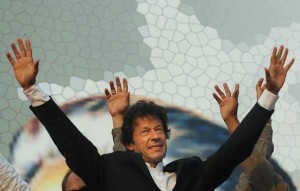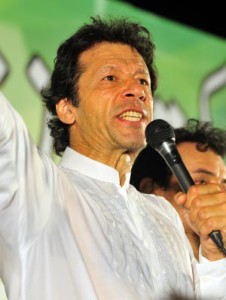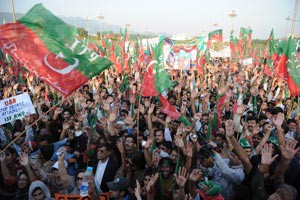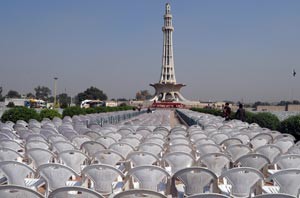The Great Leap Forward: Imran Khan’s Soaring Popularity
By Fahd Husain | News & Politics | Published 14 years ago
Imran Khan continues to make progress in his nationwide campaign to make the PTI a major political force in the country. After a successful rally in Peshawar last week and the massive political win scored when Shah Mehmood Qureshi joined the PTI leadership over the weekend, Imran’s “PTI tsunami” seems to be building on its momentum. If the addition of ex-foreign minister Qureshi can give Khan an “in” with Sindh voters, the PPP will definitely have something real to worry about. Of course, Qureshi alone will not be enough to help the PTI make a breakthrough in Sindh. Alliances with smaller parties and other powerful provincial political personalities will likely be needed. The lack of depth in the PTI’s “second line of leadership” also needs to be addressed. While Khan’s next big rally is on December 25, the real test, the next federal election, is much further down the road, and so it is impossible to say how things will turn out. But for now, at least, the PTI are riding a wave of surging popularity, and Khan believes that victory is his. In an interview with Quatrina Hosain on Express 24/7, Khan said, “We will sweep the elections…in the past year I’ve seen people change…I could see that the youth had suddenly woken up and decided that there was only one party that stood for the change they wanted.”
In the article below (our cover story from our November 2011 print edition which was published immediately after the Lahore jalsa on October 30) Fahd Husain looks at Khan’s strengths and weaknesses, and provides an impartial assessment of the former cricketer’s chances of emerging from the political wilderness to rise to the prime minister’s house. [Note: And then visit our polls page where we ask: Would you vote for Imran Khan as prime minister?].
– Online Editor

But does he have what it takes?
The story of Imran Khan is well known to all Pakistanis. Whatever gaps were left have been filled to an extent, in his own words, in his latest book published recently. Imran is now pounding the pavements like never before — he knows very well that the coming elections may pass the final verdict on his political career. For more than a decade he has struggled to find a foothold on the slippery slope of Pakistani politics and has not succeeded by any conventional measure.
Now, finally, he appears to have found traction. But a huge question mark still hangs over his party’s electoral fortunes as the arena heats up for the final showdown. Why the sudden boost in his popularity?
Imran has not said anything that he has not been saying for years. Neither has he come up with a revolutionary plan that would set voters’ hearts on fire. In fact, if anything, his pronouncements on corruption, foreign accounts, the War on Terror and the Taliban had begun to elicit yawns. So predictable, so repetitive and so inflexible; that’s how critics described his positions. Not for nothing was he branded “Taliban Khan.”
To his credit though, Imran stuck to his position. His doggedness appears to be paying off now.
The reason: events in and around Pakistan began to re-align perceptions. In the wake of the 2008 elections, Imran Khan and his Tehreek-e-Insaf veered dangerously towards political irrelevance. With the PPP and the PML-N storming back to power after trouncing the PML-Q, the likes of Imran and the Jamaat-e-Islami, who had boycotted the polls, found themselves grazing in barren fields. A new era of democratic politics was dawning in Pakistan after nine years of Musharraf’s rule. The Charter of Democracy was being hailed as the new Magna Carta of Pakistan. Smiles, hugs and backslapping dominated political activity as the starry-eyed electorate looked on with hope.
In such a scenario, Imran had nothing to sell. The campaign to restore the judiciary was being spearheaded by the lawyers and the PML-N. Imran was seen as an ‘also-ran.’ He was out of parliament and nowhere on the streets. What kept him alive was the media ventilator through which he sucked in enough political oxygen to hang on to relevancy.
That was then.
Today, Imran is looking like a realistic alternative to the traditional political heavyweights. As he barnstorms the country, he is attracting sizeable crowds (in urban Punjab and Khyber Pakhtunkhwa), and potential allies in Sindh. The media is providing him respectable coverage and the PML-N has been forced to take him seriously.
Imran Khan, finally, has the political tailwind that eluded him all these years.
His political rise is directly proportional to the sliding credibility of the other main players. The three years of democratic rule may have provided occasional dividends like the NFC Award and the 18th Amendment, but these successes are dwarfed by the ill-effects of crippling inflation, load-shedding, gas outages and dwindling economic activity. The promised fruits of democracy have not filtered down to the people. The already tainted reputations of the traditional parties have been further tarnished by tales of rapacious corruption, nepotism and all the other standard features that define the political system as it exists in Pakistan. People, apparently, can’t live on democratic trappings alone.
In this suffocating environment, Imran’s call for change is now resonating loudly. Pakistanis, fed up with the whole rotten structure, are latching on to the glimmer of hope that Imran is promising them. Never mind the details, they say. Anything and anyone is better than the tried, tested and failed bunch of politicians who thrive on a system based on patronage and whose parties are little more than personal fiefdoms.
 In contrast, Imran stands out as a financially clean alternative with a proven record of public service in the shape of his cancer hospital in Lahore and a university in Mianwali, both catering primarily to the disadvantaged population.
In contrast, Imran stands out as a financially clean alternative with a proven record of public service in the shape of his cancer hospital in Lahore and a university in Mianwali, both catering primarily to the disadvantaged population.
So far so good. But then reality begins to gnaw at the idealism that Imran is peddling at street corners. And this reality sketches the broad contours of what may fall within the realm of the possible when hard-nosed political calculations are factored in. The electoral prospects of Imran, say analysts, lie somewhere between the two extremes being painted by himself and his opponents. On the one end is the infectious optimism of Imran himself who predicts a tsunami of support that will sweep his party into power from across the four provinces and bury his opponents under this landslide. The precedent, of course, is the PPP’s electoral victory in 1970. The other end is his total wipeout, as predicted by his opponents. He may bag a handful of seats at best, they say, regardless of the percentage of national votes cast in his favour. In the winner-takes-all system of parliamentary democracy, Imran’s candidates may garner respectable numbers in constituencies, but it won’t matter if they’re second or last — they would have still lost.
“It is Imran, and Imran alone, and he cannot possibly be at all places all the time,” says a prominent Punjabi politician who himself is mulling switching parties. “One man alone, without an electable team, can only do so much in our system,” he maintains.
This may be true, which is why in the last couple of weeks, Tehreek-e-Insaf has been coaxing the media to promote its second line of leadership. But who is this leadership?
“I want to invite PTI people to my show now,” says a talk show producer. “But other than Imran himself, I can only think of Omar Cheema and Dr Shirin Mazari.”
That’s not the only problem when it comes to getting PTI people on TV. Many MNAs refuse to sit alongside PTI representatives on television talk shows, saying they are below their “stature.” “Let them win a seat and then I will sit with them on a TV show panel,” says a PML-N MNA from Lahore. Since Pakistani talk shows thrive on familiar faces and cannot afford to drop them in favour of unknown PTI leaders, media space remains shrunk for Imran’s team. And since Imran himself refuses to be on a show with anyone except a handful like Sheikh Rasheed and Shah Mehmood Qureshi, a real debate between his party and the others remains confined to a low level.
In fact, the issue of a team and candidates continues to haunt Imran. He may put up a brave face, but the fact is that he will need people who have the capability to attract their own votes and not just bank on his brand. Charisma alone does not take care of the traditional thana/katcheri issues. Parties like the PPP and PML-N have deep roots down to the mohalla and galli level, their tentacles entrenched inside the social structure knitted around kinship and patronage.
 A belated realisation may be dawning on Imran as he is now reaching out to those ‘electables’ who he shunned in the past. Mian Azhar, the patriarch of the Arain biradari in Lahore, is the first such politician bagged by Imran. To justify this new-found flexibility in the choice of his candidates, Imran is now saying that he will accept traditional politicians as long as they have clean reputations. As for their political machinations, well, nobody’s perfect I suppose.
A belated realisation may be dawning on Imran as he is now reaching out to those ‘electables’ who he shunned in the past. Mian Azhar, the patriarch of the Arain biradari in Lahore, is the first such politician bagged by Imran. To justify this new-found flexibility in the choice of his candidates, Imran is now saying that he will accept traditional politicians as long as they have clean reputations. As for their political machinations, well, nobody’s perfect I suppose.
“Mian Azhar is becoming the gateway for biradari politicians to enter PTI,” says one of his aides. Sipping tea as he hands over a phone to Mian Azhar sitting next to him in his Garden Town home in Lahore, the aide says ever since Mian (Azhar) Sahib joined Imran, he has been reaching out to those politicians who were wary of Imran’s electoral chances. “Now you will see how ‘electables’ come to sign up for PTI,” he says proudly.
This boast might be slightly premature, but it does highlight a tried and tested trend: In Pakistan if you convince politicians you can be the ‘next big thing’ — they will rush to you in hordes. In Imran’s case, the last few weeks have begun to give this impression, especially after his big rallies in Gujranwala and Faisalabad. At some stage, the tipping point may be reached, and that is when the big political names will rush to him. Or so the PTI team says. [Vote in our poll].
But when it comes to political perceptions, nothing is more potent for the fence-sitters than the proverbial wink and nod from the establishment. And here’s where Imran is racking up brownie points.
 “He’s being propped up by the GHQ,” says a PML-N supporter at their Bhaati Gate rally in Lahore. “The army wants to dent us because Mian Nawaz Sharif is taking them on,” he says between full-throated slogans of “Go Zardari, Go.” As the music blares and shouting reaches a crescendo, the Sharif supporter leans into my ear and repeats, “You media should not support this army boy.”
“He’s being propped up by the GHQ,” says a PML-N supporter at their Bhaati Gate rally in Lahore. “The army wants to dent us because Mian Nawaz Sharif is taking them on,” he says between full-throated slogans of “Go Zardari, Go.” As the music blares and shouting reaches a crescendo, the Sharif supporter leans into my ear and repeats, “You media should not support this army boy.”
He may have been belittling Imran, but in this game of perceptions, he may have been unwittingly pointing out Imran’s latent strength: if the establishment is indeed backing him as an alternative to the two big parties, then he clearly has a realistic shot at electoral success. Imran himself has done nothing to strengthen this perception, but then neither has he vehemently denied it by targeting the army. His party members whisper quietly that this perception of having the establishment’s backing is helping them attract the ‘electables.’
“This perception may not be grounded in reality,” says a Lahore-based PTI member, “but why should we go out of our way to dispel it when it’s clearly helping us become a serious player.” [Editor’s Note: In the Peshawar PTI rally on November 25, Imran Khan did proclaim that his party had no support from “unseen backers.”]
It is not just the ‘electables’ who are getting influenced by such talk. Many voters who were not planning to vote for Imran simply because this would amount to ‘wasting’ their vote on a person who had no realistic chance of winning are now taking a second look at him. Anecdotal evidence points towards a groundswell of support for him in the urban areas, and from within those sections of society who are not in the habit of voting. It doesn’t hurt that almost all polls show Imran on top of the popularity graphs.
Perceptions, it seems, are regenerating into stronger perceptions and propelling Imran to centre stage.
But even the strongest of perceptions can only go so far in creating their own reality. Imran may be drawing crowds in central and northern Punjab and, that too in urban areas, but in the south he has yet to make a mark. The same goes for Sindh and Balochistan. In Khyber Pakhtunkhwa (KPK), he has demonstrated a significant base, but the political landscape there is cluttered with ANP, PPP and JUI presence. PTI members are banking on the fact that all three parties will take a hit because all three have enjoyed the spoils of government and none have emerged smelling of roses. In the Hazara division, PML-N’s domination appears vulnerable after the renaming of the province issue. PTI hopes it can exploit these weaknesses.
But hope in itself is usually not a good plan of action. A full-fledged electoral campaign is yet to start in these areas, and when it does, the gravy train of traditional parties will flow strong and hard. Tribal and biradri strings will be pulled, favours will be called in, patronage will be redoubled and state-sponsored projects will suddenly pick up speed. Will money speak louder than Imran’s financially bereft words of hope?
And then there is Imran’s Achilles’ heel: the rural areas. Despite the rapid urbanisation of Pakistan, rural seats in parliament still outnumber the urban ones. As yet, PTI has no significant structure in these rural areas, including in the Punjab where the party is said to have the strongest support base.
Recognising this problem, PTI leaders say they are planning to send Imran to small villages and town to canvass support in the coming days. According to the plan being chalked out, Imran will visit electorally strategic rural areas, and stay overnight in villages in a bid to ‘connect’ to this vote bank. He may also finalise local candidates during these trips, although the official announcements will wait till a later stage.
In Sindh, even PTI admits it doesn’t stand much of a chance. To offset this apparent lack of local support, PTI is negotiating alliances. Potential allies include PML-F of Pir Pagara, as well as the nationalists.
All this strategising aside, constituency-based calculations paint a bleak picture for Imran. “He may bag a few seats from urban Punjab and a handful from KP, but that’s it,” says a PPP MNA, who is happy that PTI is denting the PML-N in Punjab. “All this talk of a ‘wave’ is good to mobilise voters, but it has no basis in reality,” he says.
What then will be a barometer of success for Imran? “I would say if he gets around 10 National Assembly seats, he should be ecstatic,” says the PPP politician. “This will ensure a respectable presence for his party in parliament.”
However, some analysts believe Imran must win at least 20-30 seats to be called a success. If he manages around 30 seats in a hung parliament, they say, he could end up becoming a major player. With the establishment at his back, who knows where the post-election wheeling-dealing could take him.
All these calculations may come to naught as people go to the polls. The final outcome will not be known till then, but what is becoming clear with each passing day is that Imran Khan is reaping the dividends of the failure of traditional parties in providing good governance to the people of Pakistan. The more they bicker over spoils, the more Imran gains. At a time when India is becoming a major regional, and possibly global, powerhouse, an increasing number of Pakistanis are getting disillusioned by the way the country has been run by a mix of the military and civilian elite. The status quo in Pakistan — as is obvious — has failed to deliver. Imran is now tapping into this deep reservoir of discontentment, in the hope that enough Pakistanis will rise above their parochial political loyalties and vote for a change they have only dreamt of.
Is Imran Khan then the hope that Pakistanis are looking for? In the absence of a traditional political base, this hope and expectation that Pakistanis have from him, may be his biggest strength as a politician.
And, perhaps, also his biggest weakness.
Related Articles:
This article was the cover story in the November 2011 issue of Newsline and was published under the headline “The Great Leap Forward.”


